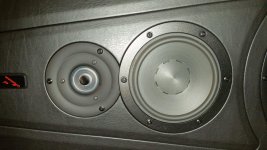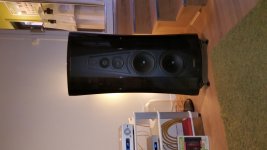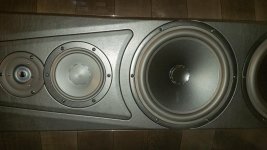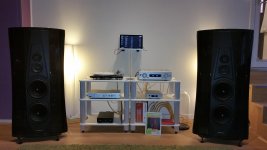I don't know what they preach in economics class, but around here the wealthy provide jobs for the rest of us, some of whom start their own business[es], etc., though admittedly, if our country succeeds in finishing its conversion to socialism it will become pretty much a two class system.
GM
I read somewhere, probably Guardian, that if wealth was divided more evenly the global economic would be healthier. But then who would buy our speakers?
what makes you say B&W has "top quality drive units"? because the replacement price is bloated high? drivers are pretty cheap to make for the vast majority of commercial brands.
Because not only have I seen measurements of a few of them I own and use the FST myself as my midrange driver. Zaph has also measured this too (Zaph|Audio scroll down till you find it) and this was at a time when the replacement cost $170 or so. B&W have since bumped the price up I am sure to stop DIYers from wanting to buy them. Even still something like the Accuton C173-6-090 would be the only real competition for it and at $827?

Regardless of how much B&W actually sell replacement parts for the quality is still present in their loudspeakers. Sure they cut corners if they can, everyone does, but on the whole you are getting a lot of speaker for your money. My only complaints with their designs is the xover design.
Yeah drivers are pretty cheap to make but this doesn't stop everyone from selling them at ridiculous prices, such as the Accuton above. If SB Acoustics can make excellent performing drivers with well engineered motors and lots of copper in the gap, why can't everyone else? Even the 5" Satori driver over here costs about £80. A comparable SEAS driver costs £165 and a comparable Scan driver £225. For all intents and purposes the Satori actually has the best performing motor out of all of them and comparable build quality elsewhere.
I've had a chance to listen to the Performas. I liked them but I found they had an odd exaggerated horn sound. They seemed to find the sound of the sax reeds and really focus on them. Do you think that was a bad demo I got?
No idea and to be honest it doesn't matter, the tonal balance is mainly attributed to the balance designed into the final product, not the drivers used within (providing they are properly used). The point is that there are many commercial loudspeakers out there significantly below $15k that use quality drive units.
The fact the McIntosh uses lots of cheaper drive units is of no surprise. They have to. They use so many of them (Even if the speakers do cost $45k). And the fact that some loudspeakers use less than the best drivers isn't a surprise either. Lots don't though.
I have listened to the B&W 802. Very boring sound, and not at all impressed by that yellow midrange driver.
I was just at the store and tried the Sonus Faber Stradivari Homage priced at about €42k with an Ayre AX-5 Twenty class AB amp (€10k). It sounded okay, but bass was inflated (room?) And the ring radiator tweeter had a lot of distortion. That danish midrange unit is interesting, but lacks in detail compared to horns. Overall it was excellent for rock and electronica for some reason, but for detailed slow jazz I really prefer my horns.
I was just at the store and tried the Sonus Faber Stradivari Homage priced at about €42k with an Ayre AX-5 Twenty class AB amp (€10k). It sounded okay, but bass was inflated (room?) And the ring radiator tweeter had a lot of distortion. That danish midrange unit is interesting, but lacks in detail compared to horns. Overall it was excellent for rock and electronica for some reason, but for detailed slow jazz I really prefer my horns.
Attachments
Last edited:
Infinity R263
I have the Infinity R263 - the top of the most recent "reference" line. After reading "Sound Reproduction: Loudspeakers and Rooms" by Floyd Toole (highly recommended!) I thought I should have a pair of "his" speakers on hand. Reference, indeed...
Toole recently retired as head of R&D for Harman, the parent company for Infinity and Revel (among others). Thus, recent Infinity speakers closely follow his development philosophy, which is entirely informed by well-controlled, large scale blind listening tests. Through extensive testing he developed a model of measurable parameters that can predict subjective preference. In other words, they know exactly what factors matter to the listeners, and in what amount - so development effort can be expended sensibly.
The main predictors of loudspeaker preference, this research indicates, are:
- smoothly falling off-axis response (hence the waveguide tweeters)
- smooth, flat axial response (hence the "natural and transparent" voicing)
- low bass extension (hence the low cabinet tuning on top-of-the-line models)
Here is a picture of the R263:
Here is a review with measurements:
Infinity R263 Floorstanding Speaker Reviewed
Somehow I managed to buy my pair of R263's (b-stock?) for around $350 CDN. At that price, there's absolutely nothing I can build that will touch their performance - I mean the drivers are easily worth that much. In truth they are pretty hard to fault at their retail price ($1000 USD / pair), and are approaching "optimal" for a traditional floorstanding speaker. My only qualm is a narrow peak (-40dB) in 3rd harmonic distortion around 1kHz, which sticks out on the measurements because the rest of the the midrange HD is way down at -60dB range. Sometimes I think I can hear it, but its far from obvious. The bass performance is insanely good, as is the tweeter / waveguide combo. Virtually no off-axis coloration even at +- 60 degrees.
At that price, there's absolutely nothing I can build that will touch their performance - I mean the drivers are easily worth that much. In truth they are pretty hard to fault at their retail price ($1000 USD / pair), and are approaching "optimal" for a traditional floorstanding speaker. My only qualm is a narrow peak (-40dB) in 3rd harmonic distortion around 1kHz, which sticks out on the measurements because the rest of the the midrange HD is way down at -60dB range. Sometimes I think I can hear it, but its far from obvious. The bass performance is insanely good, as is the tweeter / waveguide combo. Virtually no off-axis coloration even at +- 60 degrees.
Irrelevant to this discussion, but generally important, are Toole's strong recommendations for 5.1 surround sound (which performs better than ambisonics and is virtually ideal for a single listener), and use of multiple subwoofers (at least two, preferably four, to destructively drive room modes) for all program material.
I'm not able to find comparable pictures of the Infinity Reference Series and Perf 3. I haven't heard any of them. Could you post a coupld of links?
I have the Infinity R263 - the top of the most recent "reference" line. After reading "Sound Reproduction: Loudspeakers and Rooms" by Floyd Toole (highly recommended!) I thought I should have a pair of "his" speakers on hand. Reference, indeed...
Toole recently retired as head of R&D for Harman, the parent company for Infinity and Revel (among others). Thus, recent Infinity speakers closely follow his development philosophy, which is entirely informed by well-controlled, large scale blind listening tests. Through extensive testing he developed a model of measurable parameters that can predict subjective preference. In other words, they know exactly what factors matter to the listeners, and in what amount - so development effort can be expended sensibly.
The main predictors of loudspeaker preference, this research indicates, are:
- smoothly falling off-axis response (hence the waveguide tweeters)
- smooth, flat axial response (hence the "natural and transparent" voicing)
- low bass extension (hence the low cabinet tuning on top-of-the-line models)
Here is a picture of the R263:
An externally hosted image should be here but it was not working when we last tested it.
Here is a review with measurements:
Infinity R263 Floorstanding Speaker Reviewed
Somehow I managed to buy my pair of R263's (b-stock?) for around $350 CDN.
Irrelevant to this discussion, but generally important, are Toole's strong recommendations for 5.1 surround sound (which performs better than ambisonics and is virtually ideal for a single listener), and use of multiple subwoofers (at least two, preferably four, to destructively drive room modes) for all program material.
And if we're talking $15,000 you can get Vivid's entry level stand mounter.
Just curious. Can any of the members here heard the Vivids? What were your impressions?
Thanks,
Deon
No loudspeaker is worth that sort of money! Totally absurd.
Depending on how much money you have
I heard a set of Sound Lab speakers, cost hundred thousand, I never experienced anything like them, simply fantastic.
Just curious. Can any of the members here heard the Vivids? What were your impressions?
Thanks,
Deon
Didn't like them when i first heard them at the Joburg show many years ago. Turns out still don't like them. Maybe it's all those Bennic caps in the crossovers...or the plastic shells.
You know, speaking of Sound Labs, one item that is never discussed is the somatic experience of loudspeakers. That is, how your body, as opposed to your ears, experience music. A recent article from Stereofool where the reviewer was left sobbing and weeping makes me think that this dimension is ripe for research.
Best,
Erik
Best,
Erik
Hi Guangui,
I'm not able to find comparable pictures of the Infinity Reference Series and Perf 3. I haven't heard any of them. Could you post a couple of links?
I also have not heard the Monitor Platinum series either.
Of the Revel line, I've only heard the floor standing Revel F208's. The upper presence region was exaggerated to my ears, but it may also have been the recordings. I would not be surprised if they were deliberately juiced up. I remember the salesperson saying it was the most natural sounding horns ever, when I was thinking to myself, I've never heard horns sounding like they were being played by a Tupperware container.
The truth is that since discovering XSim, I hardly pay attention to commercial speakers anymore. The F208 and Wilson Sophia were the last two commercial speakers I spent much time listening to. I did go to the California Audio Show in 2015, but the rooms were so poor sounding I hardly made any good impressions.
I think you got a bad demo of the F208's, the Perf3 are one of the most natural sounding speakers I have heard. But, amplification was extremely good, so was the source. Like I said it was a Mark Levinson amplifier that had been modified by who is probably the best tech in the island and also the local ML dealer. Source was an OPPO BR/CDP
I have the Infinity R263 - the top of the most recent "reference" line. After reading "Sound Reproduction: Loudspeakers and Rooms" by Floyd Toole (highly recommended!) I thought I should have a pair of "his" speakers on hand. Reference, indeed...
Toole recently retired as head of R&D for Harman, the parent company for Infinity and Revel (among others). Thus, recent Infinity speakers closely follow his development philosophy, which is entirely informed by well-controlled, large scale blind listening tests. Through extensive testing he developed a model of measurable parameters that can predict subjective preference. In other words, they know exactly what factors matter to the listeners, and in what amount - so development effort can be expended sensibly.
The main predictors of loudspeaker preference, this research indicates, are:
- smoothly falling off-axis response (hence the waveguide tweeters)
- smooth, flat axial response (hence the "natural and transparent" voicing)
- low bass extension (hence the low cabinet tuning on top-of-the-line models)
Here is a picture of the R263:
An externally hosted image should be here but it was not working when we last tested it.
Here is a review with measurements:
Infinity R263 Floorstanding Speaker Reviewed
Somehow I managed to buy my pair of R263's (b-stock?) for around $350 CDN.At that price, there's absolutely nothing I can build that will touch their performance - I mean the drivers are easily worth that much. In truth they are pretty hard to fault at their retail price ($1000 USD / pair), and are approaching "optimal" for a traditional floorstanding speaker. My only qualm is a narrow peak (-40dB) in 3rd harmonic distortion around 1kHz, which sticks out on the measurements because the rest of the the midrange HD is way down at -60dB range. Sometimes I think I can hear it, but its far from obvious. The bass performance is insanely good, as is the tweeter / waveguide combo. Virtually no off-axis coloration even at +- 60 degrees.
Irrelevant to this discussion, but generally important, are Toole's strong recommendations for 5.1 surround sound (which performs better than ambisonics and is virtually ideal for a single listener), and use of multiple subwoofers (at least two, preferably four, to destructively drive room modes) for all program material.
Great info, and your opinion and review is basically what I have been told by other owners and people who have extensively auditioned the newer Infinity Ref. Series. Don't know what the deal is, but have seen excellent pricing on many reputable AV sales websites, like Crutchfield.
When I listened to the Revel's it was with Halo A21 (200Wpc) amplifiers. I ended up getting the amps, but not the speakers. Now I got rid of the amps in favor of ICEpower blocks.Same sound, 1/10th the idle power and easier to hide.
You would hear more of a difference comparing a Firstwatt F5 or a 2A3 or 45 tube amp against the Ice power. There is something with class D amps that annoy me. AB amps are usually okay but the best for me is a simple circuit that gets hot like hell.
You would hear more of a difference comparing a Firstwatt F5 or a 2A3 or 45 tube amp against the Ice power. There is something with class D amps that annoy me. AB amps are usually okay but the best for me is a simple circuit that gets hot like hell.
I'm sure I would hear a difference, not sure I'd like it!
The A23's I bought were class A to 20 watts. ICEpower 250ASP sound identical. Tells me I'm approaching some good level of neutrality. I actually was expecting to hear a huge difference, or be annoyed, or find the treble too hard.... but none of that was true.
I was thinking of doing the F6 build, but don't want to do any case fabrication and at the end of the day not nearly enough power for my home theater needs. I may however steal the input transformers. I think Jeff Rowland was doing something like that in his $4k ICEPower amps. I'm sorely tempted to see what an input transformer would do for me.
Best,
Erik
- Status
- This old topic is closed. If you want to reopen this topic, contact a moderator using the "Report Post" button.
- Home
- Loudspeakers
- Multi-Way
- I heard the $45,000 McIntosh XRT1K



